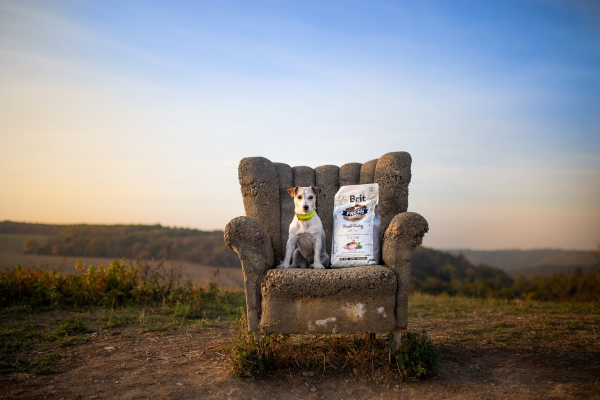Obezita koček
V dnešní době jsou civilizačním chorobám vystaveni i naši mazlíci. Obezita, stejně jako lidem, nesvědčí ani jim. Víte, jak poznáte obezitu u své kočky, jaké jsou její příčiny a důsledky?
Most of us care about the contents of the packages with dry food but have you ever thought about the packaging itself? Do you know what is used for the packaging of dry food, how different are individual materials and what innovations can you find on the dry food packaging?


It is said “don’t judge a book by its cover” and it is true...to a certain extent. It is true that the attractiveness of the dry food packaging does not matter. However, its quality does. Most of us pick our companions’ food looking at its contents. We study the labels but we often forget to look at the packaging itself. What are the advantages and disadvantages of various types of packaging and its materials?
Plastic packaging is used most commonly. Or the combination of plastic, aluminium and paper. Nowadays, when we tend to think about the environment, it might seem as creating unnecessary waste but some brands of superpremium dry food think about the environment in the production and they offer recyclable packages with their products. The fact is that this type of packaging is practical – solid, it doesn’t usually get damaged during transport and you’ll often find useful innovations on it.
Another packaging material is paper. It is easily torn compared to plastic and its production is more expensive. However, it is the friendliest option with regard to the environment. Its permeability is also an advantage, as the dry food does not get steamed even at worse conditions. And let’s look at the third option – aluminium packaging. They are the most solid option but also the most expensive.
With regard to environment, the larger the package the better, of course. However, these might be difficult to store. The packaging itself might help if there is a zip fastener. The food will be sealed in a dry and dark environment then. Also barrels might be good for storage. However, the ones that are not completely tight won’t keep the contents fresh for so long.
A great advantage of large packages (at least for me) is a handle for carrying. Well, taking a bag with 15 kilograms of dry food is not an easy thing. Therefore, the handle is a very useful thing. It also makes it easier to put the food to a barrel later.
An alternative might be buying bulk feed. This option is possible in many vet shops – they will give you as much as you need from a large package. However, there is a disadvantage that you don’t how long the package is opened and in what conditions it is stored. Therefore, you need to trust the seller.
Quality dry food should therefore be packed in quality materials, even though their design does not have to be attractive. The graphics is usually simple and clean. How do you deal with packaging for dry food? Do you think about what is practical or environmentally friendly or you don’t care at all?


V dnešní době jsou civilizačním chorobám vystaveni i naši mazlíci. Obezita, stejně jako lidem, nesvědčí ani jim. Víte, jak poznáte obezitu u své kočky, jaké jsou její příčiny a důsledky?


Opět začíná sezóna klíšťat, a tak je na čase začít před nimi naše mazlíky chránit. Tito parazité totiž psy krom boreliózy ohrožují i anaplazmózou. A fakt, že je toto onemocnění nepříliš známé, neubírá na jeho vážnosti. Víte, na co si máte dát pozor?


Jen když se řekne kočičí mor, možná vám – chovatelům kočiček – naskočí husí kůže. Právě tímto označením se někdy nazývá panleukopénie, velmi nebezpečná kočičí nemoc. Lze jí nejen předejít, ale i včas odhalit její příznaky, jen je nutné mít informace.


Každá, byť sebemenší operace s sebou samozřejmě nese určitá rizika. Jde také jak o psychickou, tak o fyzickou zátěž zvířete. Sepsala jsem tedy pár tipů, jak rizika i zátěž co nejvíce eliminovat.


Minule jsem vám vysvětlila, že alergie na srst jako taková neexistuje. Řekli jsme si o alergenech, o příznacích alergie a jak je to s hypoalergenními plemeny. Dneska vám poradím, jak se s alergií vypořádat, aniž byste se museli mazlíka zbavovat....


Věděli jste, že pojem “alergie na srst” je vlastně nesmyslný? Alergenem totiž nejsou samotné chlupy. Na co přesně má tedy člověk alergii, pokud je alergický na psy nebo kočky a musí se hned zvířete zbavovat, pokud u něj taková alergie vznikne? A...


O tom, jak cítí bolest psi a jak ji (ne)projevují, už jsem psala. Pojďme se tedy podívat, jak je to s kočkami. U nich totiž není mnohdy jednoduché bolest vůbec zpozorovat. Pro jejich zdraví a pohodu je ale včasné rozpoznání problému důležité.


Morčata patří k nejčastějším mazlíčkům, které rodiče pořizují dětem. Jsou totiž podstatně méně náročná na péči než kočka či pes. Mezi hlodavci zase vynikají svojí společenskostí, mazlivostí a bezproblémovostí. Velkou výhodou také je, že na rozdíl od...


Jistě jste si všimli, že kočky mají dost jedinečné jazyky. Jsou drsné a tak nějak škrábou. Americkým biologům tato podivnost vrtala hlavou. Proto se rozhodli, že tomu přijdou na kloub.


V Česku poměrně nový psí sport zvaný dog racing „připlul“ do Evropy ze zámoří. Zatímco v USA je tento sport výhradně pro teriéry, v našich končinách se mu mohou věnovat prakticky kterákoliv psí plemena, včetně kříženců. A v čem že toto závodění spočívá?


Kočky jsou známé svou malou chutí k pití. To ale neznamená, že pravidelný a hlavně dostatečný příjem tekutin není pro jejich zdraví potřebný. Víte, jak můžete kočičce zvýšit chuť k pití?


Není zrovna jednoduchá věc podívat se kočce do tlamy. Koneckonců i u některých psů je to boj. Nicméně pokud chcete mít zdravého a spokojeného parťáka, je to třeba čas od času podstoupit. Kočičí i psí tlamu totiž dokáže potrápit nejeden problém a sami...